radio SKODA FABIA 2004 1.G / 6Y User Guide
[x] Cancel search | Manufacturer: SKODA, Model Year: 2004, Model line: FABIA, Model: SKODA FABIA 2004 1.G / 6YPages: 247
Page 47 of 247
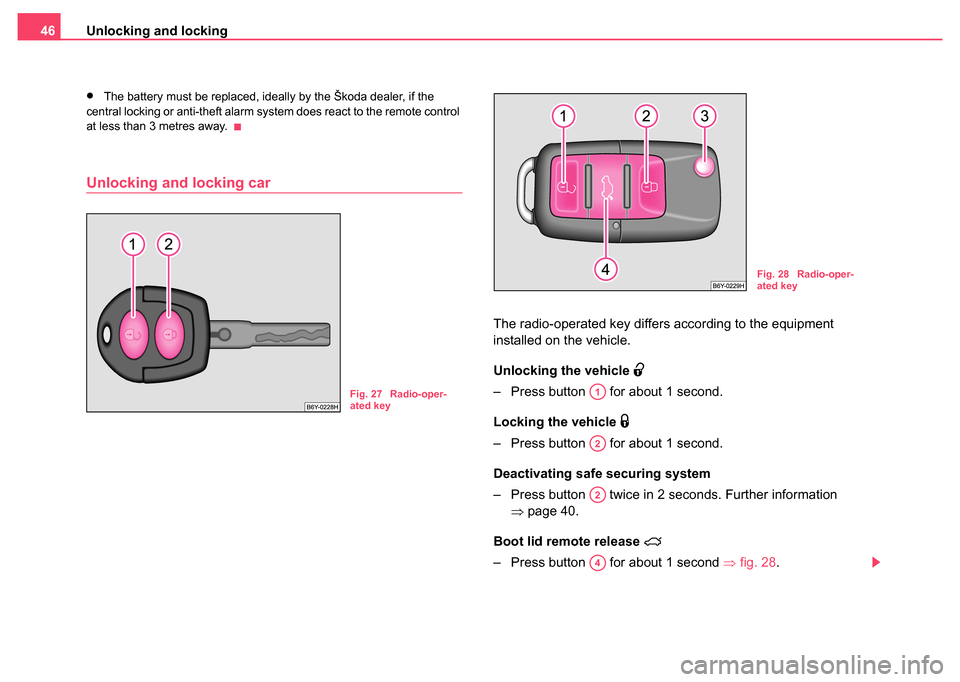
Unlocking and locking
46
•The battery must be replaced, ideally by the Škoda dealer, if the
central locking or anti-theft alarm system does react to the remote control
at less than 3 metres away.
Unlocking and locking car
The radio-operated key differs according to the equipment
installed on the vehicle.
Unlocking th e vehicle
– Press button for about 1 second.
Locking the vehicle
– Press button for about 1 second.
Deactivating safe securing system
– Press button twice in 2 seconds. Further information ⇒page 40.
Boot lid remote release
– Press button for about 1 second ⇒fig. 28 .
Fig. 27 Radio-oper-
ated key
Fig. 28 Radio-oper-
ated key
A1
A2
A2
A4
Page 48 of 247
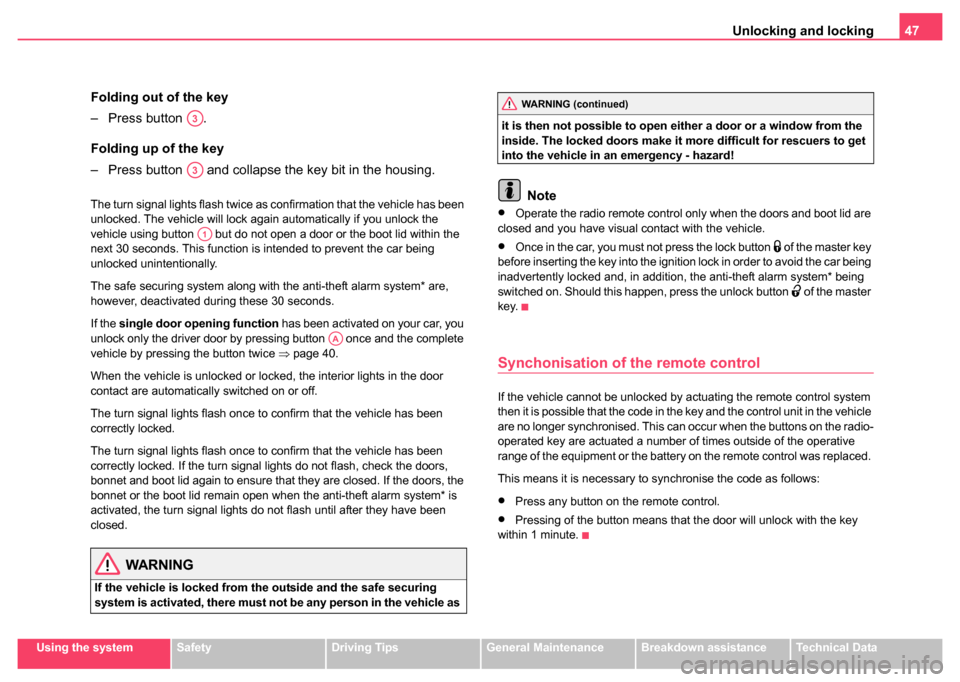
Unlocking and locking47
Using the systemSafetyDriving TipsGeneral MaintenanceBreakdown assistanceTechnical Data
Folding out of the key
– Press button .
Folding up of the key
– Press button and collapse the key bit in the housing.
The turn signal lights flash twice as confirmation that the vehicle has been
unlocked. The vehicle will lock again automatically if you unlock the
vehicle using button but do not open a door or the boot lid within the
next 30 seconds. This function is intended to prevent the car being
unlocked unintentionally.
The safe securing system along with the anti-theft alarm system* are,
however, deactivated during these 30 seconds.
If the single door opening function has been activated on your car, you
unlock only the driver door by pressing button once and the complete
vehicle by pressing the button twice ⇒page 40.
When the vehicle is unlocked or locked, the interior lights in the door
contact are automatically switched on or off.
The turn signal lights flash once to confirm that the vehicle has been
correctly locked.
The turn signal lights flash once to confirm that the vehicle has been
correctly locked. If the turn signal lights do not flash, check the doors,
bonnet and boot lid again to ensure that they are closed. If the doors, the
bonnet or the boot lid remain open when the anti-theft alarm system* is
activated, the turn signal lights do not flash until after they have been
closed.
WARNING
If the vehicle is locked from the outside and the safe securing
system is activated, there must not be any person in the vehicle as it is then not possible to open either a door or a window from the
inside. The locked doors make it more difficult for rescuers to get
into the vehicle in an emergency - hazard!
Note
•Operate the radio remote control only when the doors and boot lid are
closed and you have visual contact with the vehicle.
•Once in the car, you must not press the lock button of the master key
before inserting the key into the ignition lock in order to avoid the car being
inadvertently locked and, in addition, the anti-theft alarm system* being
switched on. Should this happen, press the unlock button
of the master
key.
Synchonisation of the remote control
If the vehicle cannot be unlocked by actuating the remote control system
then it is possible that the code in the key and the control unit in the vehicle
are no longer synchronised. This can occur when the buttons on the radio-
operated key are actuated a number of times outside of the operative
range of the equipment or the battery on the remote control was replaced.
This means it is necessary to synchronise the code as follows:
•Press any button on the remote control.
•Pressing of the button means that the door will unlock with the key
within 1 minute.
A3
A3
A1
AA
WARNING (continued)
Page 49 of 247
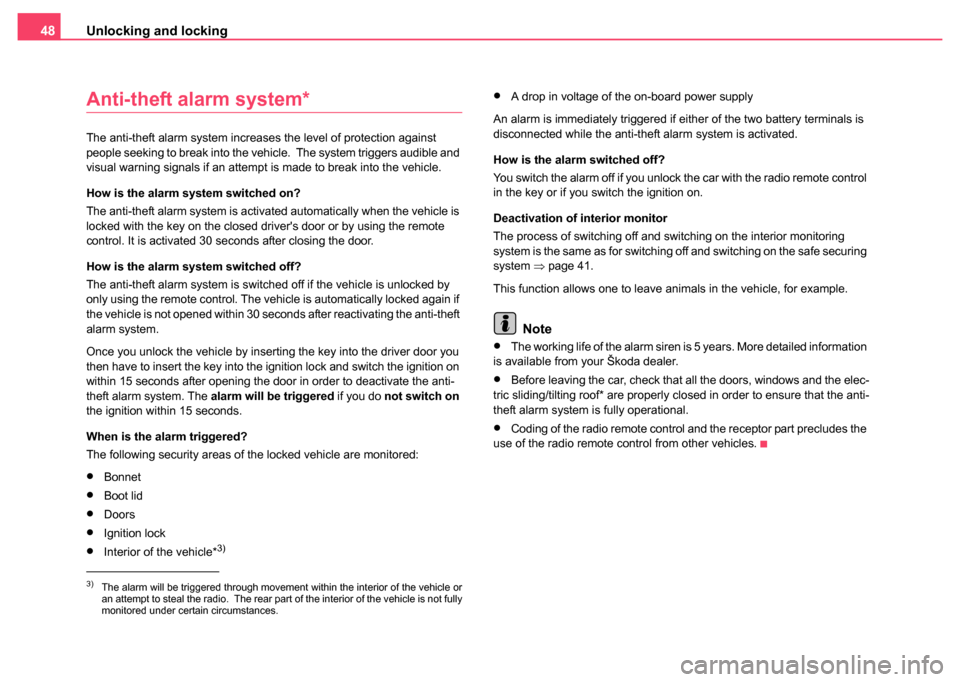
Unlocking and locking
48
Anti-theft alarm system*
The anti-theft alarm system increases the level of protection against
people seeking to break into the vehicle. The system triggers audible and
visual warning signals if an attempt is made to break into the vehicle.
How is the alarm system switched on?
The anti-theft alarm system is activated automatically when the vehicle is
locked with the key on the closed driver's door or by using the remote
control. It is activated 30 seconds after closing the door.
How is the alarm system switched off?
The anti-theft alarm system is switched off if the vehicle is unlocked by
only using the remote control. The vehicle is automatically locked again if
the vehicle is not opened within 30 seconds after reactivating the anti-theft
alarm system.
Once you unlock the vehicle by inserting the key into the driver door you
then have to insert the key into the ignition lock and switch the ignition on
within 15 seconds after opening the door in order to deactivate the anti-
theft alarm system. The alarm will be triggered if you do not switch on
the ignition within 15 seconds.
When is the alarm triggered?
The following security areas of the locked vehicle are monitored:
•Bonnet
•Boot lid
•Doors
•Ignition lock
•Interior of the vehicle*3)
•A drop in voltage of the on-board power supply
An alarm is immediately triggered if either of the two battery terminals is
disconnected while the anti-theft alarm system is activated.
How is the alarm switched off?
You switch the alarm off if you unlock the car with the radio remote control
in the key or if you switch the ignition on.
Deactivation of interior monitor
The process of switching off and switching on the interior monitoring
system is the same as for switching off and switching on the safe securing
system ⇒page 41.
This function allows one to leave animals in the vehicle, for example.
Note
•The working life of the alarm siren is 5 years. More detailed information
is available from your Škoda dealer.
•Before leaving the car, check that all the doors, windows and the elec-
tric sliding/tilting roof* are properly closed in order to ensure that the anti-
theft alarm system is fully operational.
•Coding of the radio remote control and the receptor part precludes the
use of the radio remote control from other vehicles.
3)The alarm will be triggered through movement within the interior of the vehicle or
an attempt to steal the radio. The rear part of the interior of the vehicle is not fully
monitored under certain circumstances.
Page 116 of 247

Communication115
Using the systemSafetyDriving TipsGeneral MaintenanceBreakdown assistanceTechnical Data
Communication
Universal telephone connection*
A telephone mount is factory-fitted. The mount is attached to the
centre console. Adapter “Cullmann” and mobile phone are not
factory-fitted by Škoda Auto.
Initialisation
– Withdraw the ignition key.
– First insert the adapter without the mobile phone into the
mount in the direction of arrow ⇒fig. 97 until the
adapter is touching the stop. Press the adapter slightly in the
direction of arrow until it locks into position. – Plug the adapter cable into the mobile phone socket. The
power socket is located under the front passenger storage
compartment.
– Switch on the ignition.
– Wait for approximately 15 seconds, switch off ignition.
– Insert the mobile phone into the adapter (as specified in manufacturer's instructions) and switch on the ignition.
Removing the mobile phone and adapter
– Press the button and remove the mobile telephone.
An initialisation must be carried out:
•after the first connection of the adapter
•after reconnecting the battery
•after pulling out the adapter cable from the power socket for the mobile
phone
This enables you to make full use of the advantages of a normal carphone
(“handsfree system” using a microphone integrated in the vehicle, optimal
transmission of signals using an external aerial etc.). The battery of the
mobile phone is also constantly charged.
Please contact your Škoda dealer If there are any points which are not
clear.
Please also refer to the additional instructions ⇒page 116, “Mobile
phones and two-way radio systems”.
Fig. 97 Universal tele-
phone connection
ABA1
A2
AA
AC
Page 117 of 247

Communication
116
Mobile phones and two-way radio
systems
The installation of mobile phones and two-way radio systems in a vehicle
should generally be undertaken by a Škoda dealer.
Škoda Auto permits the operation of mobile phones and two-way radio
systems with a professionally installed external aerial and a maximum
transmission power of up to 10 watts.
Our Škoda dealers are also happy to inform you about the possibilities
available for installing and operating mobile telephones and radio trans-
mitters which have an output greater than 10 watts. The Škoda dealers
can provide you with details about the technical possibilities for retrofitting
of mobile telephones and radio transmitters.
Operation of mobile phones or two-way radio systems may interfere with
functioning of the electronic systems of your vehicle. The reasons for this
may be:
•no external aerial
•external aerial incorrectly installed
•transmission power greater than 10 watts.
You should therefore not operate a mobile phone or two-way radio
system inside the vehicle without the use of an external aerial, or with
an external aerial which has been incorrectly installed.
You should also note that only an external aerial makes it possible to
achieve the optimal range of such equipment.
WARNING
•If a mobile phone or two-way radio system is operated inside the
vehicle without using an external aerial, or with an external aerial which has been incorrectly installed, the result can be excessive
electromagnetic fields which ma
y cause harm to your health.
•Please always pay full attention to the traffic situation around
you!
•You must not install two-way radio systems, mobile phones or
mounts on the covers of the airbags or within the immediate
deployment range of airbags. This might result in injuries to the
occupants in the event of an accident.
Note
Please also refer to the operating instructions of the mobile phones and
two-way radio systems.
The CD changer*
The CD changer for the car radio and navigation system is located under
the front passenger seat. A description of how to change the CD can be
found in the operating instructions for the CD changer.
WARNING (continued)
Page 171 of 247
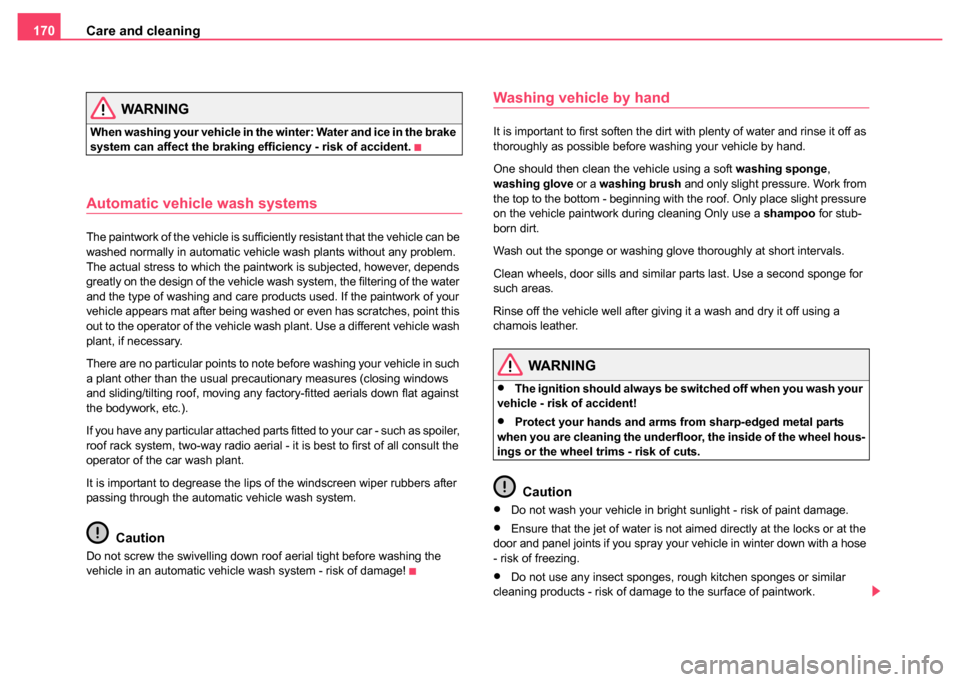
Care and cleaning
170
WARNING
When washing your vehicle in the winter: Water and ice in the brake
system can affect the braking efficiency - risk of accident.
Automatic vehicle wash systems
The paintwork of the vehicle is sufficiently resistant that the vehicle can be
washed normally in automatic vehicle wash plants without any problem.
The actual stress to which the paintwork is subjected, however, depends
greatly on the design of the vehicle wash system, the filtering of the water
and the type of washing and care products used. If the paintwork of your
vehicle appears mat after being washed or even has scratches, point this
out to the operator of the vehicle wash plant. Use a different vehicle wash
plant, if necessary.
There are no particular points to note before washing your vehicle in such
a plant other than the usual precautionary measures (closing windows
and sliding/tilting roof, moving any factory-fitted aerials down flat against
the bodywork, etc.).
If you have any particular attached parts fitted to your car - such as spoiler,
roof rack system, two-way radio aerial - it is best to first of all consult the
operator of the car wash plant.
It is important to degrease the lips of the windscreen wiper rubbers after
passing through the automatic vehicle wash system.
Caution
Do not screw the swivelling down roof aerial tight before washing the
vehicle in an automatic vehicle wash system - risk of damage!
Washing vehicle by hand
It is important to first soften the dirt with plenty of water and rinse it off as
thoroughly as possible before washing your vehicle by hand.
One should then clean the vehicle using a soft washing sponge,
washing glove or a washing brush and only slight pressure. Work from
the top to the bottom - beginning with the roof. Only place slight pressure
on the vehicle paintwork during cleaning Only use a shampoo for stub-
born dirt.
Wash out the sponge or washing glove thoroughly at short intervals.
Clean wheels, door sills and similar parts last. Use a second sponge for
such areas.
Rinse off the vehicle well after giving it a wash and dry it off using a
chamois leather.
WARNING
•The ignition should always be switched off when you wash your
vehicle - risk of accident!
•Protect your hands and arms from sharp-edged metal parts
when you are cleaning the underfloor, the inside of the wheel hous-
ings or the wheel trims - risk of cuts.
Caution
•Do not wash your vehicle in bright sunlight - risk of paint damage.
•Ensure that the jet of water is not aimed directly at the locks or at the
door and panel joints if you spray your vehicle in winter down with a hose
- risk of freezing.
•Do not use any insect sponges, rough kitchen sponges or similar
cleaning products - risk of damage to the surface of paintwork.
Page 198 of 247
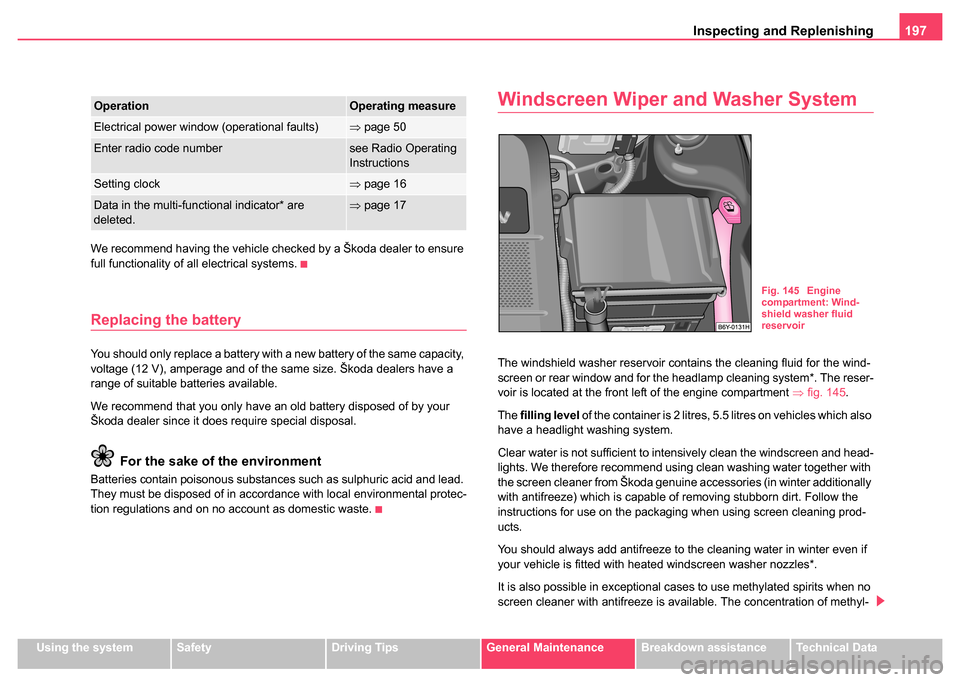
Inspecting and Replenishing197
Using the systemSafetyDriving TipsGeneral MaintenanceBreakdown assistanceTechnical Data
We recommend having the vehicle checked by a Škoda dealer to ensure
full functionality of all electrical systems.
Replacing the battery
You should only replace a battery with a new battery of the same capacity,
voltage (12 V), amperage and of the same size. Škoda dealers have a
range of suitable batteries available.
We recommend that you only have an old battery disposed of by your
Škoda dealer since it does require special disposal.
For the sake of
the environment
Batteries contain poisonous substances such as sulphuric acid and lead.
They must be disposed of in accordance with local environmental protec-
tion regulations and on no account as domestic waste.
Windscreen Wiper and Washer System
The windshield washer reservoir contains the cleaning fluid for the wind-
screen or rear window and for the headlamp cleaning system*. The reser-
voir is located at the front left of the engine compartment ⇒fig. 145 .
The filling level of the container is 2 litres, 5.5 litres on vehicles which also
have a headlight washing system.
Clear water is not sufficient to intensively clean the windscreen and head-
lights. We therefore recommend using clean washing water together with
the screen cleaner from Škoda genuine accessories (in winter additionally
with antifreeze) which is capable of removing stubborn dirt. Follow the
instructions for use on the packaging when using screen cleaning prod-
ucts.
You should always add antifreeze to the cleaning water in winter even if
your vehicle is fitted with heated windscreen washer nozzles*.
It is also possible in exceptional cases to use methylated spirits when no
screen cleaner with antifreeze is available. The concentration of methyl-
OperationOperating measure
Electrical power window (operational faults) ⇒ page 50
Enter radio code numbersee Radio Operating
Instructions
Setting clock⇒page 16
Data in the multi-functional indicator* are
deleted.⇒page 17
Fig. 145 Engine
compartment: Wind-
shield washer fluid
reservoir
Page 207 of 247
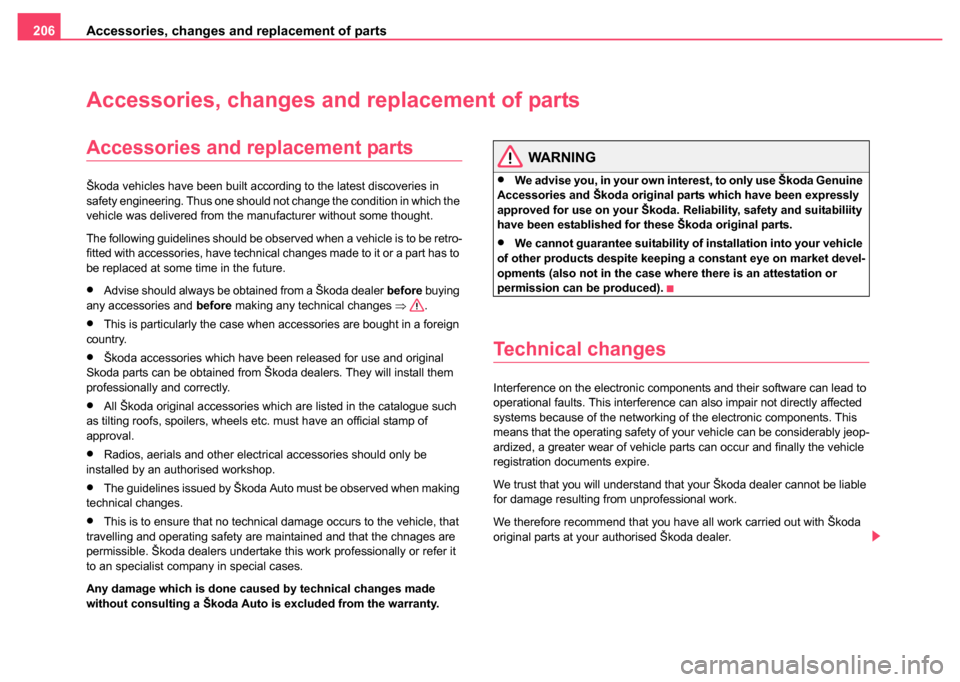
Accessories, changes and replacement of parts
206
Accessories, changes an d replacement of parts
Accessories and replacement parts
Škoda vehicles have been built according to the latest discoveries in
safety engineering. Thus one should not change the condition in which the
vehicle was delivered from the manufacturer without some thought.
The following guidelines should be observed when a vehicle is to be retro-
fitted with accessories, have technical changes made to it or a part has to
be replaced at some time in the future.
•Advise should always be obtained from a Škoda dealer before buying
any accessories and before making any technical changes ⇒.
•This is particularly the case when accessories are bought in a foreign
country.
•Škoda accessories which have been released for use and original
Skoda parts can be obtained from Škoda dealers. They will install them
professionally and correctly.
•All Škoda original accessories which are listed in the catalogue such
as tilting roofs, spoilers, wheels etc. must have an official stamp of
approval.
•Radios, aerials and other electrical accessories should only be
installed by an authorised workshop.
•The guidelines issued by Škoda Auto must be observed when making
technical changes.
•This is to ensure that no technical damage occurs to the vehicle, that
travelling and operating safety are maintained and that the chnages are
permissible. Škoda dealers undertake this work professionally or refer it
to an specialist company in special cases.
Any damage which is done caused by technical changes made
without consulting a Škoda Auto is excluded from the warranty.
WARNING
•We advise you, in your own interest, to only use Škoda Genuine
Accessories and Škoda original parts which have been expressly
approved for use on your Škoda. Reliability, safety and suitabiliity
have been established for these Škoda original parts.
•We cannot guarantee suitability of installation into your vehicle
of other products despite keeping a constant eye on market devel-
opments (also not in the case where there is an attestation or
permission can be produced).
Technical changes
Interference on the electronic components and their software can lead to
operational faults. This interference can also impair not directly affected
systems because of the networking of the electronic components. This
means that the operating safety of your vehicle can be considerably jeop-
ardized, a greater wear of vehicle parts can occur and finally the vehicle
registration documents expire.
We trust that you will understand that your Škoda dealer cannot be liable
for damage resulting from unprofessional work.
We therefore recommend that you have all work carried out with Škoda
original parts at your authorised Škoda dealer.
Page 228 of 247
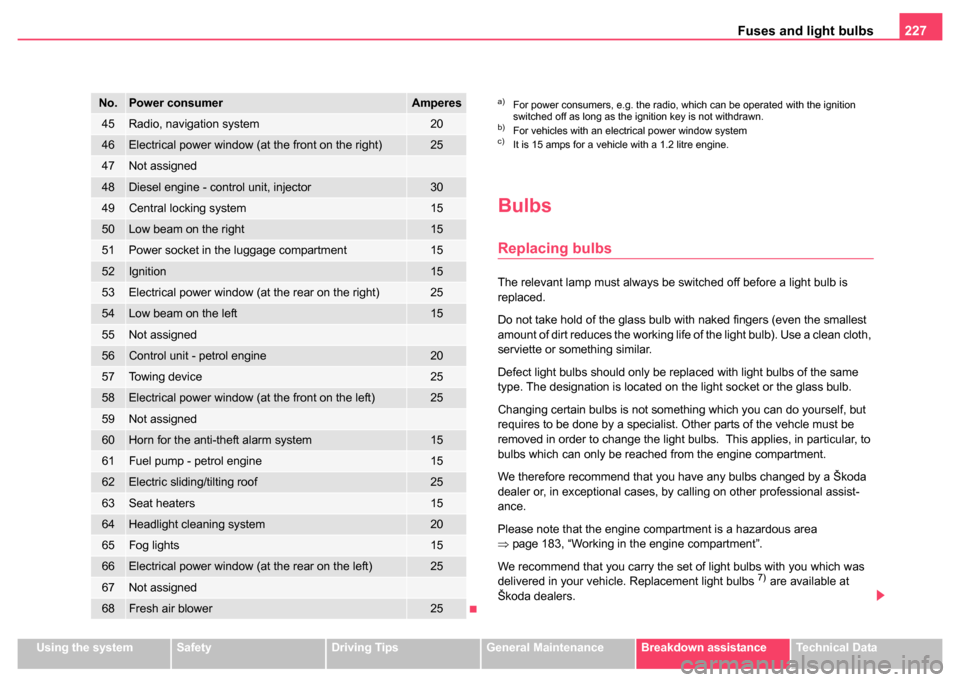
Fuses and light bulbs227
Using the systemSafetyDriving TipsGeneral MaintenanceBreakdown assistanceTechnical Data
Bulbs
Replacing bulbs
The relevant lamp must always be switched off before a light bulb is
replaced.
Do not take hold of the glass bulb with naked fingers (even the smallest
amount of dirt reduces the working life of the light bulb). Use a clean cloth,
serviette or something similar.
Defect light bulbs should only be replaced with light bulbs of the same
type. The designation is located on the light socket or the glass bulb.
Changing certain bulbs is not something which you can do yourself, but
requires to be done by a specialist. Other parts of the vehcle must be
removed in order to change the light bulbs. This applies, in particular, to
bulbs which can only be reached from the engine compartment.
We therefore recommend that you have any bulbs changed by a Škoda
dealer or, in exceptional cases, by calling on other professional assist-
ance.
Please note that the engine compartment is a hazardous area
⇒page 183, “Working in the engine compartment”.
We recommend that you carry the set of light bulbs with you which was
delivered in your vehicle. Replacement light bulbs
7) are available at
Škoda dealers.
45Radio, navigation system20
46Electrical power window (at the front on the right)25
47Not assigned
48Diesel engine - control unit, injector30
49Central locking system15
50Low beam on the right15
51Power socket in the luggage compartment15
52Ignition15
53Electrical power window (at the rear on the right)25
54Low beam on the left15
55Not assigned
56Control unit - petrol engine20
57Towing device25
58Electrical power window (at the front on the left)25
59Not assigned
60Horn for the anti-theft alarm system15
61Fuel pump - petrol engine15
62Electric sliding/tilting roof25
63Seat heaters15
64Headlight cleaning system20
65Fog lights15
66Electrical power window (at the rear on the left)25
67Not assigned
68Fresh air blower25
No.Power consumerAmperesa)For power consumers, e.g. the radio, which can be operated with the ignition
switched off as long as the ignition key is not withdrawn.
b)For vehicles with an electrical power window systemc)It is 15 amps for a vehicle with a 1.2 litre engine.
Page 243 of 247
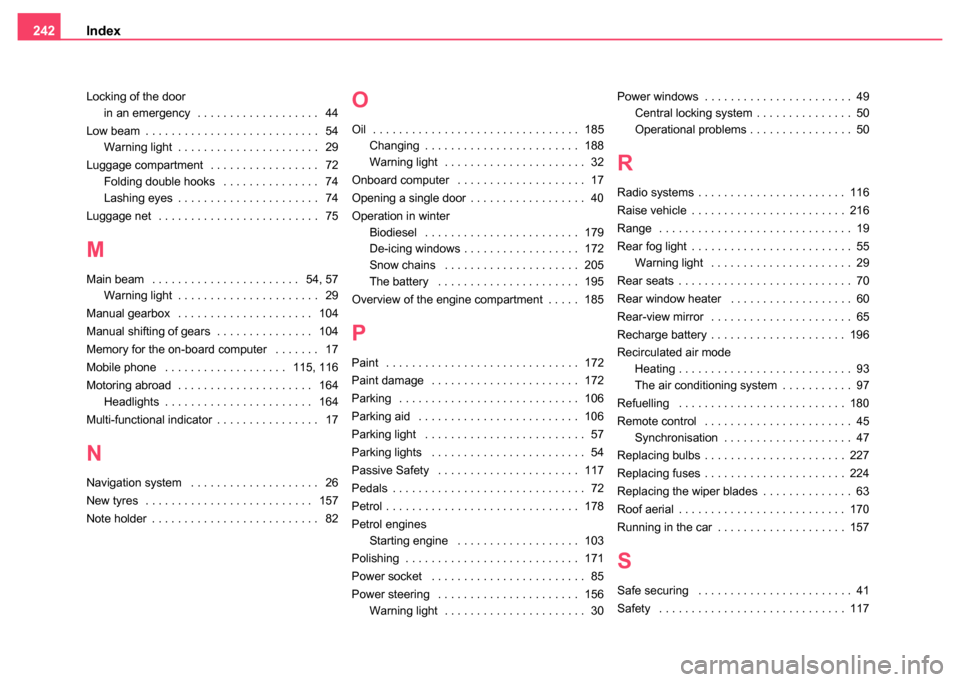
Index
242
Locking of the door
in an emergency . . . . . . . . . . . . . . . . . . . 44
Low beam . . . . . . . . . . . . . . . . . . . . . . . . . . . 54 Warning light . . . . . . . . . . . . . . . . . . . . . . 29
Luggage compartment . . . . . . . . . . . . . . . . . 72 Folding double hooks . . . . . . . . . . . . . . . 74
Lashing eyes . . . . . . . . . . . . . . . . . . . . . . 74
Luggage net . . . . . . . . . . . . . . . . . . . . . . . . . 75
M
Main beam . . . . . . . . . . . . . . . . . . . . . . . 54, 57 Warning light . . . . . . . . . . . . . . . . . . . . . . 29
Manual gearbox . . . . . . . . . . . . . . . . . . . . . 104
Manual shifting of gears . . . . . . . . . . . . . . . 104
Memory for the on-board computer . . . . . . . 17
Mobile phone . . . . . . . . . . . . . . . . . . . 115, 116
Motoring abroad . . . . . . . . . . . . . . . . . . . . . 164 Headlights . . . . . . . . . . . . . . . . . . . . . . . 164
Multi-functional indicator . . . . . . . . . . . . . . . . 17
N
Navigation system . . . . . . . . . . . . . . . . . . . . 26
New tyres . . . . . . . . . . . . . . . . . . . . . . . . . . 157
Note holder . . . . . . . . . . . . . . . . . . . . . . . . . . 82
O
Oil . . . . . . . . . . . . . . . . . . . . . . . . . . . . . . . . 185 Changing . . . . . . . . . . . . . . . . . . . . . . . . 188
Warning light . . . . . . . . . . . . . . . . . . . . . . 32
Onboard computer . . . . . . . . . . . . . . . . . . . . 17
Opening a single door . . . . . . . . . . . . . . . . . . 40
Operation in winter Biodiesel . . . . . . . . . . . . . . . . . . . . . . . . 179
De-icing windows . . . . . . . . . . . . . . . . . . 172
Snow chains . . . . . . . . . . . . . . . . . . . . . 205
The battery . . . . . . . . . . . . . . . . . . . . . . 195
Overview of the engine compartment . . . . . 185
P
Paint . . . . . . . . . . . . . . . . . . . . . . . . . . . . . . 172
Paint damage . . . . . . . . . . . . . . . . . . . . . . . 172
Parking . . . . . . . . . . . . . . . . . . . . . . . . . . . . 106
Parking aid . . . . . . . . . . . . . . . . . . . . . . . . . 106
Parking light . . . . . . . . . . . . . . . . . . . . . . . . . 57
Parking lights . . . . . . . . . . . . . . . . . . . . . . . . 54
Passive Safety . . . . . . . . . . . . . . . . . . . . . . 117
Pedals . . . . . . . . . . . . . . . . . . . . . . . . . . . . . . 72
Petrol . . . . . . . . . . . . . . . . . . . . . . . . . . . . . . 178
Petrol engines Starting engine . . . . . . . . . . . . . . . . . . . 103
Polishing . . . . . . . . . . . . . . . . . . . . . . . . . . . 171
Power socket . . . . . . . . . . . . . . . . . . . . . . . . 85
Power steering . . . . . . . . . . . . . . . . . . . . . . 156 Warning light . . . . . . . . . . . . . . . . . . . . . . 30 Power windows . . . . . . . . . . . . . . . . . . . . . . . 49
Central locking system . . . . . . . . . . . . . . . 50
Operational problems . . . . . . . . . . . . . . . . 50
R
Radio systems . . . . . . . . . . . . . . . . . . . . . . . 116
Raise vehicle . . . . . . . . . . . . . . . . . . . . . . . . 216
Range . . . . . . . . . . . . . . . . . . . . . . . . . . . . . . 19
Rear fog light . . . . . . . . . . . . . . . . . . . . . . . . . 55Warning light . . . . . . . . . . . . . . . . . . . . . . 29
Rear seats . . . . . . . . . . . . . . . . . . . . . . . . . . . 70
Rear window heater . . . . . . . . . . . . . . . . . . . 60
Rear-view mirror . . . . . . . . . . . . . . . . . . . . . . 65
Recharge battery . . . . . . . . . . . . . . . . . . . . . 196
Recirculated air mode Heating . . . . . . . . . . . . . . . . . . . . . . . . . . . 93
The air conditioning system . . . . . . . . . . . 97
Refuelling . . . . . . . . . . . . . . . . . . . . . . . . . . 180
Remote control . . . . . . . . . . . . . . . . . . . . . . . 45 Synchronisation . . . . . . . . . . . . . . . . . . . . 47
Replacing bulbs . . . . . . . . . . . . . . . . . . . . . . 227
Replacing fuses . . . . . . . . . . . . . . . . . . . . . . 224
Replacing the wiper blades . . . . . . . . . . . . . . 63
Roof aerial . . . . . . . . . . . . . . . . . . . . . . . . . . 170
Running in the car . . . . . . . . . . . . . . . . . . . . 157
S
Safe securing . . . . . . . . . . . . . . . . . . . . . . . . 41
Safety . . . . . . . . . . . . . . . . . . . . . . . . . . . . . 117